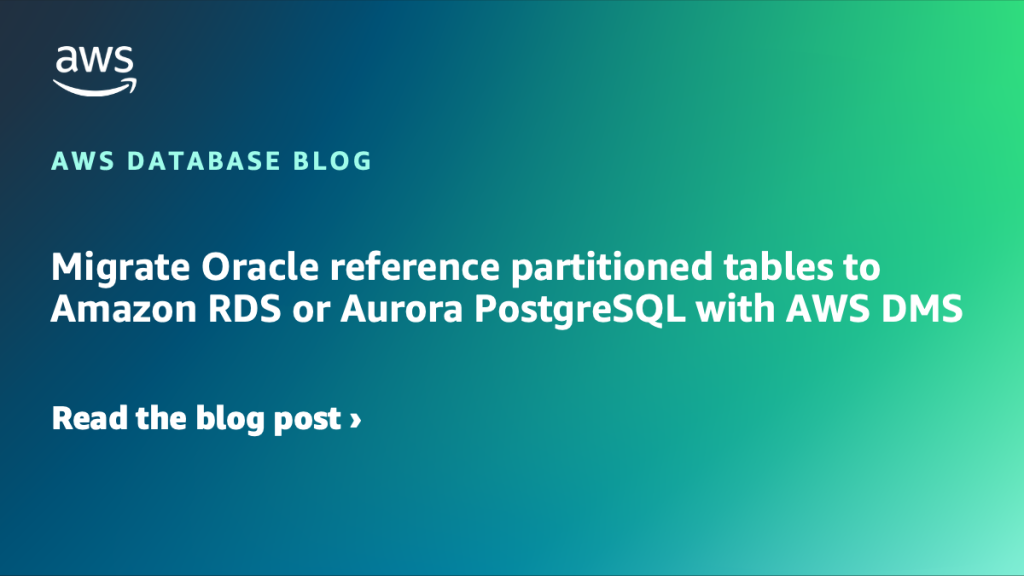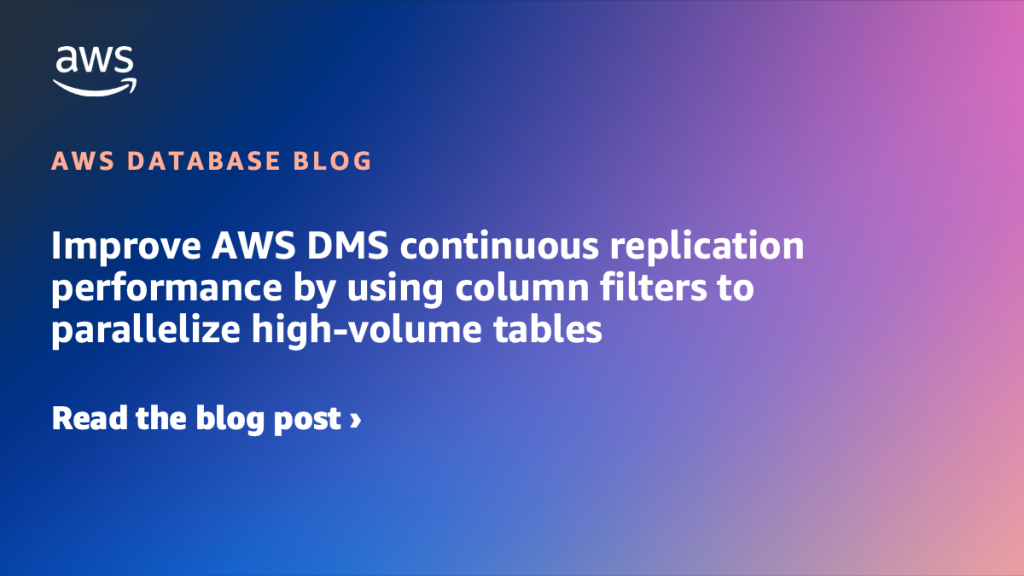AWS Database Blog
Category: AWS Database Migration Service
Migrate Oracle reference partitioned tables to Amazon RDS or Aurora PostgreSQL with AWS DMS
Database migrations from Oracle to PostgreSQL are becoming increasingly common as organizations seek to optimize database costs while leveraging the benefits of open-source database solutions. However, these migrations present specific challenges, particularly when dealing with an Oracle-specific feature such as reference partitioning, which doesn’t have a direct equivalent in PostgreSQL. In this post, we show you how to migrate Oracle reference-partitioned tables to Amazon RDS for PostgreSQL or Amazon Aurora PostgreSQL-Compatible Edition using AWS DMS.
Improve AWS DMS continuous replication performance by using column filters to parallelize high-volume tables
In this post, we explore how you can use column filters to divide a high-activity table into multiple tasks during the CDC phase. This approach can accelerate the migration process and reduce target latency.
How the Amazon TimeHub team designed a recovery and validation framework for their data replication framework: Part 4
With AWS DMS, you can use data validation to make sure your data was migrated accurately from the source to the target. If you enable validation for a task, AWS DMS begins comparing the source and target data immediately after a full load is performed for a table. In this post, we describe the custom framework we built on top of AWS DMS validation tasks to maintain data integrity as part of the ongoing replication between source and target databases.
Stream change data in a multicloud environment using AWS DMS, Amazon MSK, and Amazon Managed Service for Apache Flink
When workloads and their corresponding transactional databases are distributed across multiple cloud providers, it can create challenges in using the data in near real time for advanced analytics. In this post, we discuss architecture, approaches, and considerations for streaming data changes from the transactional databases deployed in other cloud providers to a streaming data solution deployed on AWS.
Configure SSL encryption on an SAP ASE source endpoint in AWS DMS
In this post, we walk you through how to configure Secure Sockets Layer (SSL) encryption between the source endpoints in AWS DMS and an on-premises SAP ASE source for secure data transfer. We also show you the steps for enabling SSL on an on-premises SAP ASE database. Configuring SSL encryption on source endpoints enables encrypting data in transit during the database migration process for enhanced security.
Configure change data capture parameters on Amazon RDS for SQL Server
AWS Database Migration Service (AWS DMS) is a managed migration and replication service that helps you move your database and analytic workloads to AWS quickly and securely. The source database remains fully operational during the migration, minimizing downtime to applications that rely on the database. AWS DMS can migrate data to and from most widely […]
Tune replication performance with AWS DMS for an Amazon Kinesis Data Streams target endpoint – Part 1
AWS Database Migration Service (AWS DMS) makes it possible to replicate to Amazon Kinesis Data Streams from relational databases, data warehouses, NoSQL databases, and other types of data stores. You can use Kinesis data streams to collect and process large streams of data records in real time. Replicating data changes to a Kinesis data stream […]
Orchestrate an AWS DMS Serverless replication task using AWS CLI
Database migration is a critical aspect of modern IT operations, especially when you need to switch database systems while ensuring minimal downtime and data loss. AWS DMS Serverless is a feature of AWS Database Migration Service (AWS DMS) that provides automatic provisioning, scaling, built-in high availability, and a reduced billing model based on workload changes […]
Configure an AWS DMS endpoint to access cross-account secrets from AWS Secrets Manager
AWS Database Migration Service (AWS DMS) provides integration with AWS Secrets Manager for storing the database credentials. This integration allows you to store, rotate, and retrieve credentials used in the AWS DMS endpoints. As a security best practice, customers use this integration for enhanced security control and also at times maintain a central account or […]
Implement an automated approach for handling AWS DMS operational events
AWS Database Migration Service (AWS DMS) allows you to tackle the complex task of migrating both homogenous and heterogeneous database engines. As businesses evolve, the need to adopt the most suitable database engines for their unique requirements arises. This often leads to the coexistence of various database systems, presenting challenges when it comes to seamless […]









